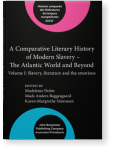Chapter 11
Haunting slavery
The Traumatic Gaze in Uncle Tom’s Cabin and A Romance of the
Republic
This chapter considers the disruptive power of two nineteenth-century literary scenes, one from
Harriet Beecher Stowe’s Uncle Tom’s Cabin (1852) and one
from Lydia Maria Child’s A Romance of the Republic (1867),
in which portrayals of enslaved women activate the emotions of readers while challenging the usual workings of
sympathy. Drawing on the work of film theorist Todd McGowan, it locates in these scenes a Lacanian gaze that unsettles
readers by looking back at them, creating an opportunity for them to see ideology as ideology. Through this approach,
the chapter identifies a textual strategy that challenges slavery and racism while pushing back against the racial
objectifications inherent in the dynamics of sympathy: a strategy that could ultimately intervene in the cultural
construction of whiteness and blackness.
This content is being prepared for publication; it may be subject to changes.
